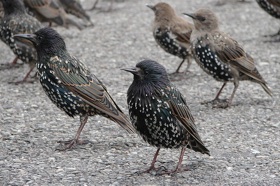By Karen Word, Department of Neurobiology, Physiology, and Behavior, University of California, Davis
Plummeting temperature, deep dark clouds cruising with a suddenly-biting wind… a storm is upon you and there you are without a coat or umbrella. What do you do? A person might pull clothing tight and run for shelter, preferably one with a warm fire and hot cocoa. But what about birds? No cozy dens, no electric blankets… how do our feathered friends cope with such nasty weather? And worse yet, what if the feathers that normally provide some protection from the elements are scraggly new ones that have only just begun to grow back during molt?
During foul weather, birds, like people, often leave aside foraging, courtship, or other important engagements to seek shelter. If miserable conditions continue for too long, birds might flee in search of fairer climes. Abrupt behavioral shifts like hiding or fleeing often come with (and may be driven by) changes in the chemistry of the blood and brain—including increases in hormones such as corticosterone (similar to cortisol in humans) or epinephrine (a.k.a. adrenaline).

While these stress hormones have previously been linked to weather events in the wild, both corticosterone and epinephrine have (ahem) a “chicken and egg” problem when it comes to explaining behavioral responses. Are these chemical responses directly brought on by poor weather, or are they subsequent side effects of something less direct, like food shortage? If the latter is true, then many assumptions about stress physiology might be wrong, including the idea that hormones drive short-term coping behaviors like hiding. If weather is the culprit, what is it about weather that causes these responses – temperature, wind, moisture, or the combination of all three? And finally, are these two stress responses coordinated or separate? Molting birds often fail to show stress responses during molt, perhaps because they interfere with feather growth, but this phenomenon has only been tested using standard lab stressors like handling and restraint. If stress hormones drive behavioral responses to bad weather, will these responses be suppressed even under storm conditions when molting birds appear to be more vulnerable?
Robert de Bruijn, a graduate student at Tufts University, addressed some of these questions in a study he presented at the 2012 SICB meeting in Charleston, SC by creating artificial weather conditions for European starlings (Sturnus vulgaris) in the lab. In his experiments, he separated out the various factors characteristic of an abrupt-onset storm: sudden drop in temperature, increase in wind, and rain.
De Bruijn’s procedure involved a portable air conditioner (with or without fan), a low-pressure garden-hose timer, and a system of plastic bins (he credits his wife for this bit of genius design), the last of which has holes for dripping “rain” on to bird cages. All of this equipment could be run with the press of a button on a remote control, instantly changing the “weather” without anyone having to enter the room. He then chilled, ruffled, or moistened two groups of starlings—non-molting and molting birds—in various combinations for 30 minutes.
To find out how birds react to these conditions, De Bruijn would have liked to measure both epinephrine and corticosterone directly and continuously. Unfortunately, epinephrine is frustratingly hard to study because it spikes so quickly during stress that it’s virtually impossible to obtain “pre-stress” samples from any animal that doesn’t like having its blood drawn (read, all of them). As an indirect indicator of epinephrine, scientists can measure heart rate; because this is the primary chemical used by the body to increase heart rate, it can be assumed that if the heart speeds up, this “fight or flight” response has been engaged. Corticosterone is easier — it changes slowly enough that the act of drawing blood doesn’t affect the immediate measurement — but you still only get one shot. So he measured the birds’ heart rates continuously, using pre-attached monitors, and took blood samples, once long before the beginning, letting birds recover from handling, and once at the end of the experiment, to look for changes in corticosterone.
All birds – molting and non-molting – beat their little hearts faster (and “normal” heart rate, in case you were wondering, starts out at 350 beats per minute!) for the entire time of exposure to cold, rain, and combinations thereof, showing an enduring “fight or flight” response with an implied role for epinephrine. De Bruijn thinks that this increase in heart rate was not because the animals were working harder to stay warm; because the change in temperature was so minor (3°C), temperature-regulating costs should be unchanged. More likely, the birds were using their changing environment as a cue that unpleasant conditions might persist or get worse, and their physiology was responding in a way that might help them make a decision to seek shelter or otherwise change their behavior appropriately.
Previous studies suggested that molting birds might ignore other stressors—like weather—to keep feather growth the top priority. Indeed, they kept corticosterone levels low, even though non-molting birds responded to weather treatments with increased stress hormones. But the molting birds bucked the trends from previous studies and responded just as strongly to weather “stress” as non-molting birds when it came to heart rate. So, weather might just be important enough to merit a response for birds with compromised rain-gear, at least in some respects.
Curiously, there were no differences in the responses to different factors or combinations of them – cold temperatures got the same response as cold rain and cold windy rain.
Any good experiment raises at least as many questions as it answers, and this one is no exception. What difference does it make to a bird if its heart rate goes up, but not corticosterone levels? Do molting birds give up an important coping strategy by protecting their feathers from corticosterone? And what exactly would they do differently if they had invented fire and tea? In any case, the next time the wind howls outside and you snuggle closer in your warm den, think for a minute about all the little beating hearts silently sheltering in the trees outside, flesh and blood attuned to the weather, adapting and balancing, secreting and responding, all just to live another day.

Karen Word (neè Lizars) originally hails from Evanston, Illinois. She attended Reed College (BA) and Portland State University (MS) and is currently working towards her PhD at UC Davis. Having spent formative years attempting to convince family and friends that science was neither scary nor impossible, she has realized her error too late to reverse course and feels obligated to perpetuate these misimpressions in her speech and writing for the foreseeable future. Reader, beware.

